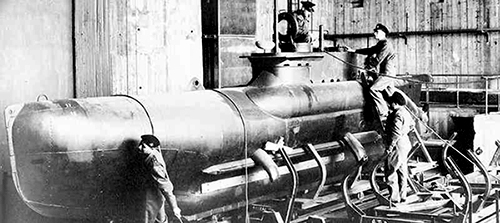
Small Battle Units War Badge
(Bewährungs und Kampfabzeichen der Kleinkampfmittel)
The Small Battle Units (Kleinkampfverbände) were formed in April 1944 under the command of Konteradmiral Heye.
Probably best known for their use of the small midget submarine types such as Neger, Biber, Molch, Seehund etc, the K-Verbände also used diverse other weapons systems such as the Sprengboote, small speedboats packed with dynamite and driven directly to their targets.
"Seehund" type XXVIIA/B
The Seehund ("seal"), also known as Type XXVII, was a successful series of German midget submarines created during World War II. Designed in 1944, and operated by two man crews, the submarines were used by the Kriegsmarine during the closing months of the war, sinking nine merchant vessels and damaging an additional three, with 35 losses mostly attributed to bad weather.
Seehund type XXVIIA (Hecht)
Like the British X class boats, the Type XXVIIA was designed to carry explosive charges to be laid beneath enemy ships, but it was markedly smaller and had substantial differences from the X class. It dispensed with a dual diesel/electric propulsion system, relying instead solely on electrical power in the form of a 12 hp AEG torpedo motor, on the basis that since it would operate submerged there was no need for a diesel engine. However, this resulted in a very low endurance of 69 nmi (128 km; 79 mi) at 4 kn (7.4 km/h; 4.6 mph).
Even though Hecht had been designed to transport an explosive charge, Karl Dönitz insisted that a torpedo be carried so that attacks could be carried out on vessels in coastal waters. On the 18th January 1944, Dönitz discussed the new design with Adolf Hitler who expressed his approval, and on 9th March contracts were placed with Germaniawerft of Kiel for construction of a prototype, followed by a further contract for 52 submarines on the 28th March.
The 53 "Hechts" were constructed between May and August 1944: in the event, none saw active service but were instead used to train Seehund crews.
Seehund type XXVIIB
As the orders were being placed, Hecht variants were under construction. The first was the Type XXVIIB, which had a greater range, could carry two G7e torpedoes, and had diesel/electric propulsion. The design was completed at the end of June 1944 and resembled Hecht but had a better boat-shaped external casing for improved seakeeping while surfaced, and saddle tanks. Additional room had been made inside the pressure hull by moving the batteries to the keel, while the two torpedoes were slung externally in recesses in the lower hull. A 22 hp diesel engine was fitted for surface use and was estimated to give a surfaced speed of 5.5 kn (10.2 km/h; 6.3 mph), with a 25 hp electric motor providing a submerged speed of 6.9 kn (12.8 km/h; 7.9 mph).
The final variant of the Type XXVII was the Type XXVIIB5, better known as the Seehund ("Seal") or Type 127. Seehund had a small raised platform midships with the air intake mast, magnetic compass, periscope, and a clear dome which could survive depths of 45 m (148 ft). The submarine's fixed 10 m (33 ft) periscope incorporated lenses which let the commander check the sky above for aircraft before surfacing.
A total of 285 Seehunds were constructed and allocated numbers in the range U-5501 to U-6442.
Seehunds operated mainly around the German coast and in the English Channel, and could attack on the surface in turbulent weather, but had to be almost stationary for submerged attacks. From January to April 1945 Seehunds performed 142 sorties, during which they sank eight ships for a total of 17,301 tons and damaged three for a total of 18,384 tons; 35 Seehunds were lost in action.

"Seahund" midget submarine
"Molch"
The Molch (newt or salamander) was an unsuccessful, one-man series of German midget submarines created during World War II. Built in 1944, it was the first mini-submarine of the Kriegsmarine, but was not successful in combat operations and suffered heavy losses.

The "Molch" midget submarine
"Biber"
The Biber (Beaver) was a German midget submarine of the Second World War. Armed with two externally mounted 21-inch (53 cm) torpedoes or mines, they were intended to attack coastal shipping. They were the smallest midget submarines in the Kriegsmarine.
The Biber was hastily developed to help meet the threat of an Allied invasion of Europe. This resulted in basic technical flaws that, combined with the inadequate training of their operators, meant they never posed a real threat to Allied shipping, despite 324 submarines being delivered. One of the class's few successes was the sinking of the cargo ship Alan A. Dale.

The "Biber" midget submarine
"Neger"
The Neger (Negro) was a German torpedo-carrying craft generally described as a human torpedo which could not submerge, but was difficult to see during night operations. The vessel was used by the Kriegsmarine between 1943 and 1945. The name comes from the constructor Richard Mohr whose surname means blackamoor.
The most dangerous, to operate, of all the weapons used by the the K-Verbände, the Neger was based on the G7e torpedo and sported a spartan cockpit covered by a perspex dome where the warhead would have been. It had sufficient positive buoyancy to run awash while supporting a second G7e, with warhead, slung below. The vessel had a range of 48 nautical miles at 4 knots and displaced 2.7 tons. The pilot navigated via a wrist compass and air was provided through a Dräger self-contained breathing device. The pilot aimed his weapon by lining up an aiming spike on the nose with a graduated scale on the dome. Subsequently, a second aiming spike was added closer to the dome. It, however, made little difference as water washing over the dome made visibility extremely poor. A simple lever in the cockpit irreversibly started the torpedo and released it. Though not designed as a suicide weapon, the Neger would frequently become one when the torpedo started running but failed to release, and carried the craft and its pilot toward the target.

The "Neger" torpedo-carrying craft
![]()
Designed by Ottfried Neubecker and instituted on the order of Grossadmiral Karl Dönitz, a special range of awards was introduced for the Kleinkampfverbände on the 30th November 1944.
The introduction order read
In recognition of the dashing attacks carried out with success by the Kleinkampfverbände, I institute for the soldiers of the K-Verbände, Bewährungs and Kampfabzeichen in the following form.
1st Grade Embroidered Sawfish.
2nd Grade Embroidered Sawfish with One Sword.
3rd Grade Embroidered Sawfish with Two Swords.
4th Grade Embroidered Sawfish with Three Swords.
5th Grade a Bronze Clasp.
6th Grade a Silver Clasp.
7th Grade a Gold Clasp.
The insignia up to the 4th Grade will be worn on the upper right arm level with the position of the Clasp above the ribbon bar.
2) The criteria for the award is general merit and fulfillment of requisite conditions.
3) The insignia is awarded in my name by the commanding admiral of the K-Verband.
1st Grade
Awarded for wear to volunteers in the Kleinkampfverbände during training and a two month probationary period.
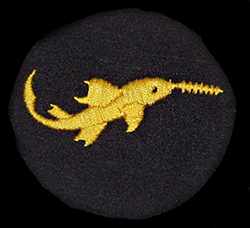
2nd Grade
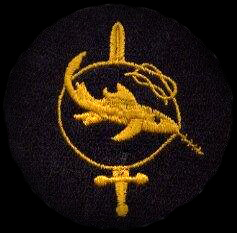
3rd Grade
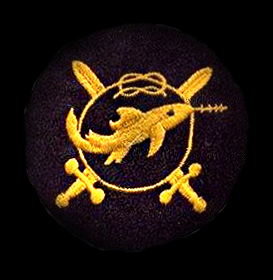
4th Grade
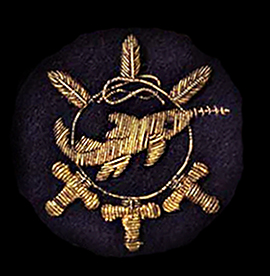
Observations by Gordon Williamson regarding the 5th, 6th and 7th grade clasp
"The vast majority if not all of those metal clasps in circulation are those produced as part of the 1957 de-Nazified series of awards.
Some of these have early wartime type hinges and pins and may be found with a variety of spurious markings (L/56, L/12, L/18 to name but three).
Fortunately there is an easy way to detect these copies. In the only verified original piece yet noted, sold by Hamburg Dealer Detlev Niemann in 1998, it is clear that the fins of the Sawfish are not ribbed, but smooth. The postwar type has the Sawfish fins ribbed."
The following clasps should not be concidered as original war-time pieces, and are for illastration purposes only.
5th Grade
(Bronze)
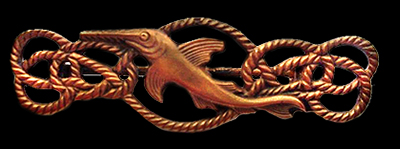
6th Grade
(Silver)
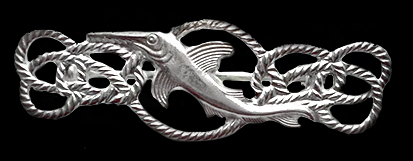
7th Grade
(Gold)
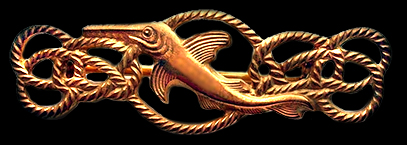
Award Documents
"Although the metal clasps seem to have been bestowed on paper, there is no evidence as yet to suggest that any were every actually issued. No award documents seem to have been produced for these awards, though original Soldbücher with entries for the lower grades in cloth are known.
Only a handful of award certificates have been encountered and these are invariably of the typewritten form, local produced from sheets of plain paper and typical of very late war awards, not the official printed blanks which would be used for most military awards."
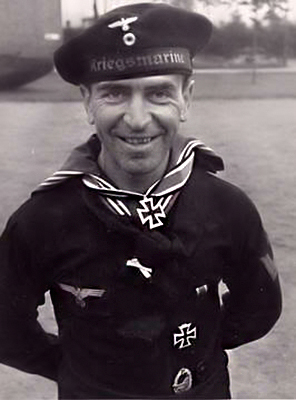
Walther Gerhold, the "Neger" Knight's Cross to the Iron Cross winner
The Knight's Cross of the Iron Cross was awarded to recognise extreme battlefield bravery or successful military leadership. Gerhold was awarded the Knight's Cross for his contribution in the Neger one man midget-submarine attack on the ORP Dragon on the nights of 5th and 6th July 1944.
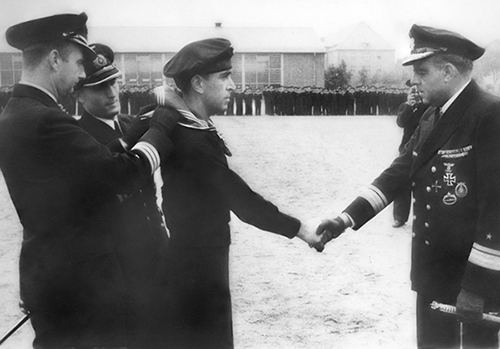
The presentation of the Knight's Cross was made by Konteradmiral Hellmuth Heye on the 14th July 1944 in Lübeck